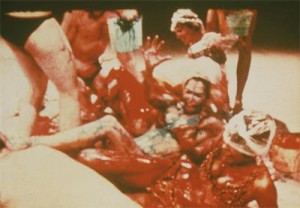Fur Wheel (1962)
Kinetic sculpture
Materials: lampshade base, fur, tin cans, mirrors, glass, oil paint; wheel, motor, electrical components
This is one of Schneemann’s first departures from the use of flat canvas and also one of the first movement based pieces she creates. The ‘wheel’ slowly rotates around in a circle, allowing the beer cans to clink and fall, which creates an organic noise. The effect of the piece is hypnotic in its monotony.



